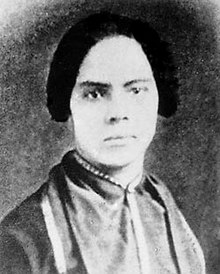

| Devoted to anti-slavery, temperance and general literature. | |

The front page of the Provincal Freeman, September 2, 1854.
| |
| Founder(s) | Mary Ann Shadd Cary |
|---|---|
| Publisher | Mary Ann Shadd Cary Samuel Ringgold Ward Isaac Shadd |
| Founded | March 24, 1853 |
| Political alignment | Abolitionist |
| Ceased publication | September 20, 1857 |
| City | Windsor, Ontario (1853-1854) Toronto, Ontario (1854-1855) Chatham, Ontario (1855-1957) |
The Provincial Freeman was a Canadian weekly newspaper founded by Mary Ann Shadd that published from 1853 through 1857. She was married to Thomas F. Cary in 1856, becoming Mary Ann Shadd Cary.[1] It was the first newspaper published by an African-American female and Canada's first by a woman of any ethnicity.[2] The paper's motto was "Devoted to anti-slavery, temperance, and general literature."[3]
Mary Ann Shadd was born in Wilmington, Delaware in 1823. After the passing of the Fugitive Slave Act of 1850, Shadd emigrated to Canada with her brother, Isaac Shadd, in 1851.[4][5]

Shadd began the Provincial Freeman in 1853. Aware that her feminine name might repel readers because of the gender expectations of 19th-century society, she persuaded Samuel Ringgold Ward, a black abolitionist who published several abolitionist newspapers, including Impartial Citizen, to help her publish the newspaper.[4][6][7] She also enlisted the help of Rev. Alexander McArthur, a white clergyman. Their names were featured on the masthead, but Mary Ann was involved in all aspects of the paper. Shadd left her full name off the masthead as both writer and editor, to hide her involvement.[3] Shadd identified herself on the masthead with only her first two initials and by listing herself as "publishing agent."[7]
The paper published in Windsor, Ontario between 1853 and 1854, in Toronto between 1854 and 1855, and in Chatham, Ontario from 1855 to 1857.[7]
In 1854, Mary Ann Shadd changed the masthead to feature her own name, rather than those of McArthur and Ward. She also hired her sister to help edit the paper. There was intense criticism of the change, and Mary Ann was forced to resign the following year.[8]
The paper's final issue was published on September 20, 1857.[7]
The Provincial Freeman's first issue was published in Windsor, Ontario, on March 24, 1853. It was the second newspaper in Canada to present the views and concerns of the Black community.[9] The paper was written for abolitionists in British North America, now Canada, and the northern United States.[5]
Women's rights were a founding principle of the Provincial Freeman—Shadd even wrote a column on it.[7]
Isaac Shadd, Mary Ann's brother, managed the daily business affairs of the newspaper. Isaac was a committed abolitionist, and would later host gatherings to plan the raid on Harper's Ferry at his home.[7] Her brother and sister, Isaac and Amelia edited the paper. Abolitionists Martin Delany, William P. Newman, Samuel Ringgold Ward and H. Ford Douglass contributed to the newspaper periodically.[5]
Mary Ann lectured throughout Canada and the United States to increase subscriptions, as well as raise funds to support escaped slaves.[4]

The impact of African-American newspapers from 1850–1860 was significant in the abolitionist movement. However, it was challenging to sustain publication. Publishers like Shadd undertook their work because of a commitment to education and advocacy, and used their newspapers as a means to influence opinion. They had to overcome financial, political, and social challenges to keep their papers afloat.[10][11][12]
Carol B. Conaway writes in "Racial Uplift: The Nineteenth Century Thought of Black Newspaper Publisher Mary Ann Shadd Cary" that these newspapers shifted the focus from whites to blacks in an empowering way. She writes that whites read these newspapers to monitor the dissatisfaction level of the treatment of African Americans and to measure their tolerance for continued slavery in America.[11]
Black newspapers often modeled their newspapers on mainstream white publications. According to research conducted by William David Sloan in his various historical textbooks, the first newspapers were about four pages and had one blank page to provide a place for people to write their own information before passing it along to friends and relatives. He goes even farther to discuss how the newspapers during these early days were the center of information for society and culture.[13][14][15][16][17]
A statue of Mary Ann Shadd Cary and a historic plaque is located at BME Freedom Park in Chatham-Kent.[2][5]
Provincial Freeman - digitized from microfilm from the University of Windsor library collection.